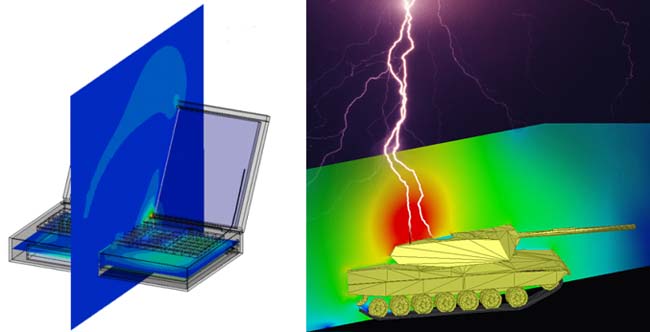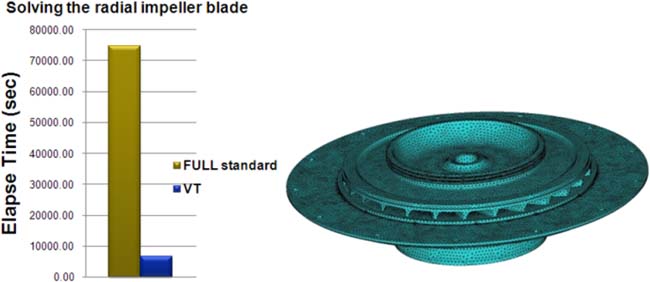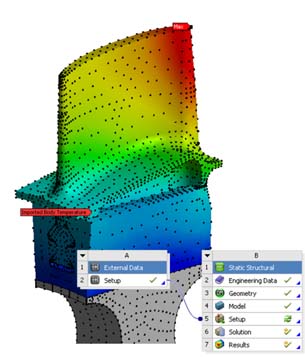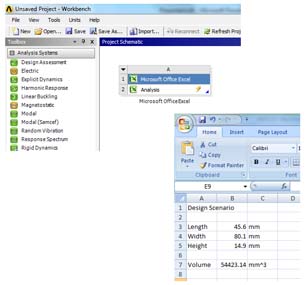Latest News
November 10, 2010
By DE Editors
ANSYS, Inc. has launched ANSYS 13.0, the newest release of its engineering simulation technology suite. ANSYS 13.0, the company reports, has been enhanced with hundreds of new features ANSYS 13.0 that deliver new benefits in three major areas—greater fidelity via new solver methods, higher productivity built on an adaptive architecture, and performance enhancements via software and computational power – leading to improved time to market and reduced development costs.
 ANSYS 13.0’s new electromagnetic transient solver enables engineers to study the electromagnetic effects in broadband and radar applications as they occur over time. Image courtesy of ANSYS, Inc. |
“ANSYS 13.0 builds on the foundation of previous ANSYS releases. It especially addresses user feedback by incorporating valuable capabilities that compress design cycles, optimize product performance across multiple physics, maximize the accuracy of virtual prototypes, and automate the simulation process,” said Jim Cashman, president and CEO of ANSYS, in a press statement. “The release will create a significant competitive advantage for users, making it easier and faster to bring innovative new products to market.”
 ANSYS 13.0 introduces a capability called variational technology (VT) that, when applied to harmonic analysis, is said to reduce solution times by a factor of five to 10 times. Image courtesy of ANSYS, Inc. |
An electromagnetic transient solver, one of a number of new solver methods in ANSYS 13.0, produces higher-fidelity results in dynamic simulation environments, according to the company. In the structural mechanics arena, 3D rezoning can be used for applications that involve large shape deformations. ANSYS explains that the latter enables engineers to stop a simulation as the mesh becomes distorted, re-mesh the material’s current state, then resume the simulation.
 A new feature called “external data mapper” imports external data in the form of a column text file defining a point cloud and projects the data onto the current mesh. The feature is said to allow users from different groups (such as CFD and structural) to exchange data in a straightforward manner. Image courtesy of ANSYS, Inc. |
The HFSS transient solver for dynamic electromagnetic simulations such as broadband and radar now incorporates automatic adaptive mesh refinement and a local time-stepping procedure said to accurately represent the geometry and fields while optimizing runtime, stability, and efficiency. In addition, a new hybrid solver serves as a bridge between finite element and integral equation methods for high-frequency electromagnetics problems.
ANSYS 13.0 offers an embedded large eddy simulation (LES) solver for modeling turbulence in fluid environments. The company says that this delivers a faster solution by applying LES to complex areas of interest and faster-solving Reynolds average Navier–Stokes (RANS) to the rest of the solution. ANSYS 13.0 also includes a new fluid dynamics capability for multiple reference frames. This, says ANSYS, means that engineers can model multiple moving systems simultaneously.
ANSYS 13.0, in the company’s opinion, is built to enhance users’ productivity, especially when running complex multiphysics engineering simulations. This release has been engineered to leverage the ANSYS foundation of open and flexible architecture, enabling customized engineering workflows that can cut time and costs from the simulation process. An integration with Microsoft Excel allows engineers to interact with spreadsheets that contain analytic representations of models and parameter table definitions. Other enhancements include a cutcell meshing feature said to produce nearly all hexahedral elements on complex 3D geometry automatically, an external data mapper that imports data in the form of a column text file defining a point cloud; and tighter integration among the Maxwell, HFSS, and mechanical solvers when performing electromagnetic-thermal-structural simulations.
ANSYS 13.0 power enhancements include a new application of variational technology that, says the company, reduces solution time by a factor of five to 10 when applied to harmonic analysis. This latest ANSYS release also features greater support for GPU processors, which can be offloaded with complex, time-consuming algorithms to increase both processing speed and accuracy.
 ANSYS 13.0 offers a new integration interface with Microsoft Excel. Image courtesy of ANSYS, Inc. |
Multiphysics integration features in ANSYS 13.0 include fluid and structural simulation tools for turbomachinery design and analysis, such as cyclic symmetry and multiple moving reference frames; new models for internal combustion engine applications—spray, ignition, and combustion; as well as new process and energy industry solutions such as multiphase, real gas, nucleate boiling, and chemical reaction tools. Meshing, element modeling, more-tightly coupled fluid-structure interaction (FSI), and nonlinear functionality are some of the additional improvements that ANSYS says round out the list of new features.
“Based on close interactions with our customers, we have designed ANSYS 13.0 to address their most pressing needs for high-quality, fast, and powerful simulation results that boost their product development efforts,” according to Cashman. “The hundreds of innovative new features in ANSYS 13.0 will make it easier and more cost-effective than ever to apply engineering simulation technology to bring new products to market confidently.”
ANSYS 13.0 will be available for customer download later this year. For details about ANSYS 13.0’s new features, visit ANSYS.
See a chart of ANSYS 13.0 capabilities.
Go here for details on certified supported platforms and CAD interfaces.
See why DE’s Editors selected ANSYS 13.0 as their Pick of the Week.
Subscribe to our FREE magazine, FREE email newsletters or both!
Latest News
About the Author
DE’s editors contribute news and new product announcements to Digital Engineering.
Press releases may be sent to them via [email protected].






